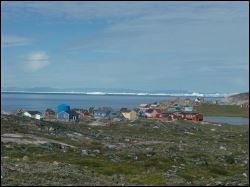Our shared heritage helps communicate our identity and our origin. We must preserve it for the next generation.
North-western Greenland has been inhabited for thousands of years. Our heritage concerns the traces of human activity and the variety of cultures that exists in towns and the open country.
In towns and settlements, heritage often covers buildings or special built environments, whereas heritage in the open country most often consists of ancient monuments or cultural landscapes left by the different Inuit cultures that once lived there.
In Qaasuitsup Municipality, heritage is given high priority and the municipality wants to create a stronger understanding and awareness of our shared cultural heritage, ensuring that these values are not lost, but preserved for the future and the next generation. This not only includes ancient heritage or special buildings, but also newer buildings or built environments that tell a story, for instance from a specific period.
Through registration, communication and information, Qaasuitsup Municipality wants, in cooperation with museums, to help foster more interest, understanding and love for our shared ancient monuments, old buildings and urban environments than is the case today.
The many historical buildings and built environments are pieces of the distinct features and identity of towns and settlements and can be considered an important resource for society. Both acting as attractive destinations for the many tourists visiting our municipality, and contributing to the daily well-being of our citizens.
What we sometimes consider ordinary can share an important story from a specific period. The Greenlandic GTO standard houses from the 50s and 60s are good examples of this. Thanks to the very favourable climatic conditions and dry climate, it will be possible to renovate and upgrade these buildings.
Each of the municipality's towns and settlements holds numerous examples of buildings or built environments that are considered historically valuable and unique, and thereby preservation-worthy heritage.
The built environment is one of the most tangible manifestations of local history and holds tales and stories that can be key to strengthening local identity and creating bonds between citizens across fields of interests.
Few places in the world are considered to possess highly special or unique preservation value across national or geographical borders. The ice fjord, Kangia, is among these places and has been appointed a world heritage site. The UNESCO world heritage convention aims to preserve the world's unique natural and cultural heritage for future generations. The Ilulissat ice fjord was appointed a world heritage site in 2004 because it is a one-of-a-kind natural phenomenon and an example of a stage from the earth's historical development in the last ice age in the Quaternary period. Interesting archaeological finds have been made at the ice fjord, documenting that the old settlement Sermermiut has been populated for 4,400 years.
To get better at caring for our shared values, we need access to and knowledge of them. Consequently, Qaasuitsup Municipality considers it an important job to communicate information about our heritage – ancient monuments, buildings and built environments – to the general public. Our heritage must be experienced with our senses in the future, coming to life. We will do this by using modern technology such as text messages, websites and 3D technology.
Another means will be to involve senior citizens, who often possess important information about our past and history, and thereby bring our heritage to life and make it relevant.




